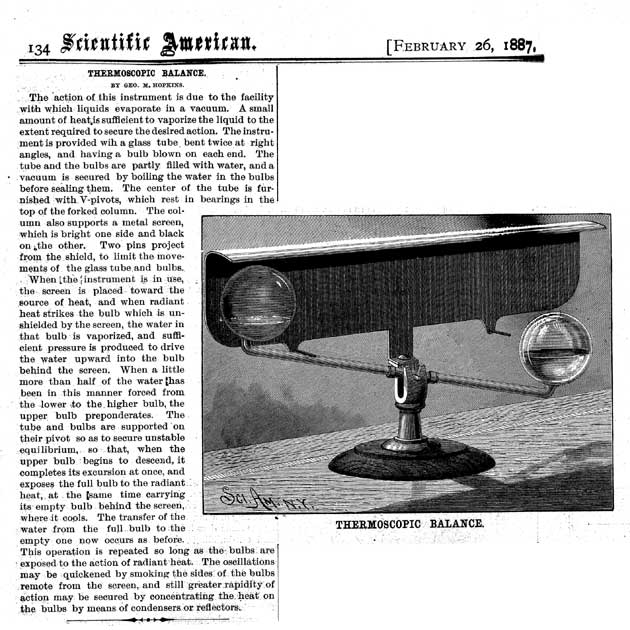Text:
Thermoscopic Balance
by Geo. M. Hopkins
From Scientific American, Feb 26, 1887 p134
The action of this instrument is due to the facility with which liquids evaporate in a vacuum. A small amount of heat is sufficient to vaporize the liquid to the extent required to secure the desired action. The instrument is provided with a glass tube bent twice at right angles, and having a bulb blown on each end. The tube and the bulbs are partly filled with water, and a vacuum is secured by boiling the water in the bulbs before sealing them. The center of the tube is furnished with V-pivots, which rest in bearings in the top of the forked column. The column also supports a metal screen, which is bright on one side and black on the other. Two pins project from the shield, to limit the movements of the glass tube and the bulbs.
When the instrument is in use, the screen is placed toward the source of heat, and when radiant heat strikes the bulb which is unshielded by the screen, the water in that bulb is vaporized, and sufficient pressure is produced to drive the water upward into the bulb behind the screen. When a little more than half of the water has been in this manner forced from the lower to the higher bulb, the upper bulb preponderates. The tube and the bulbs are supported on their pivot so as to secure unstable equilibrium, so that, when the upper bulb begins to descend, it completes its excursion at once, and exposes the full bulb to the radiant heat, at the same time carrying its empty bulb behind the screen, where it cools. The transfer of the water from the full bulb to the empty one now occurs as before. This operation is repeated so long as the bulbs are exposed to the action of radiant heat. The oscillations may be quickened by smoking the sides of the bulbs remote from the screen, and still greater rapidity of action may be secured by concentrating the heat on the bulbs by means of condensers or reflectors.







